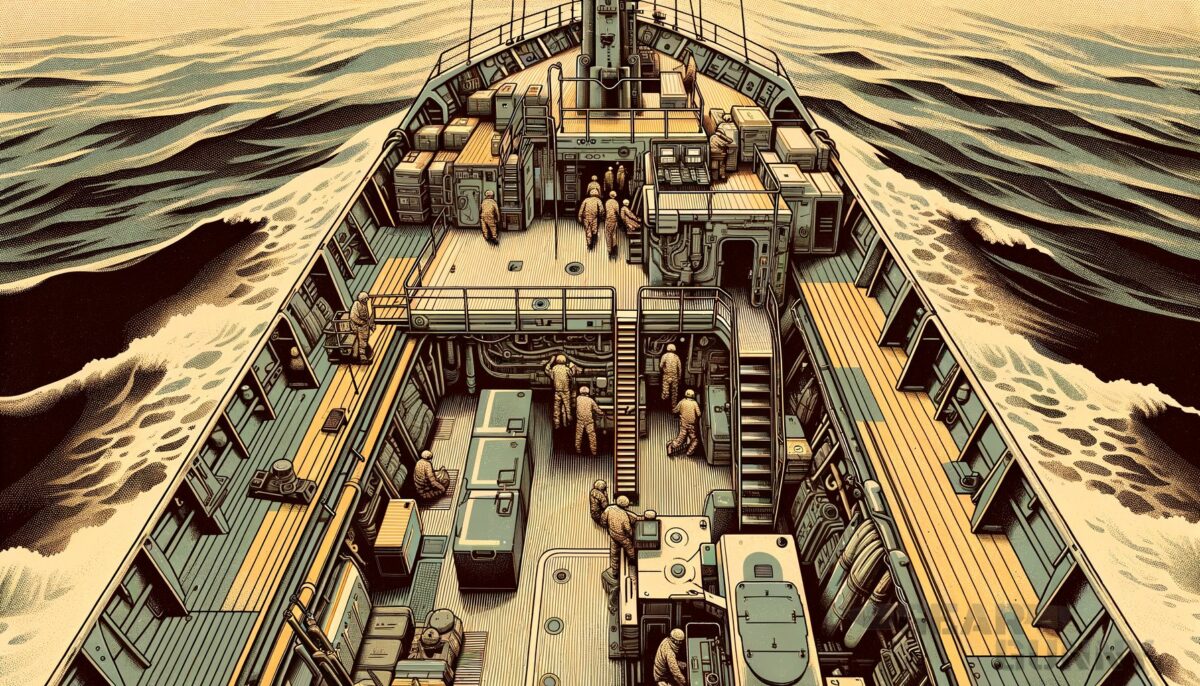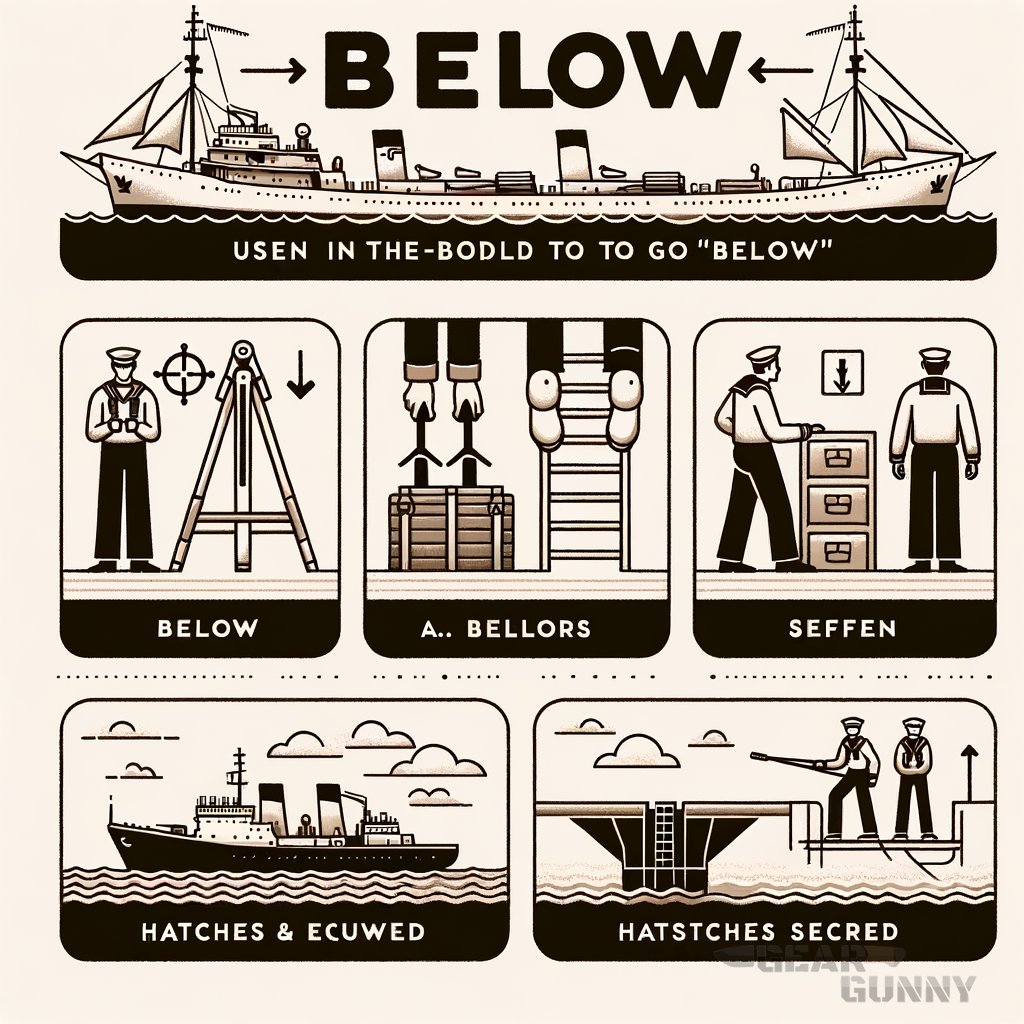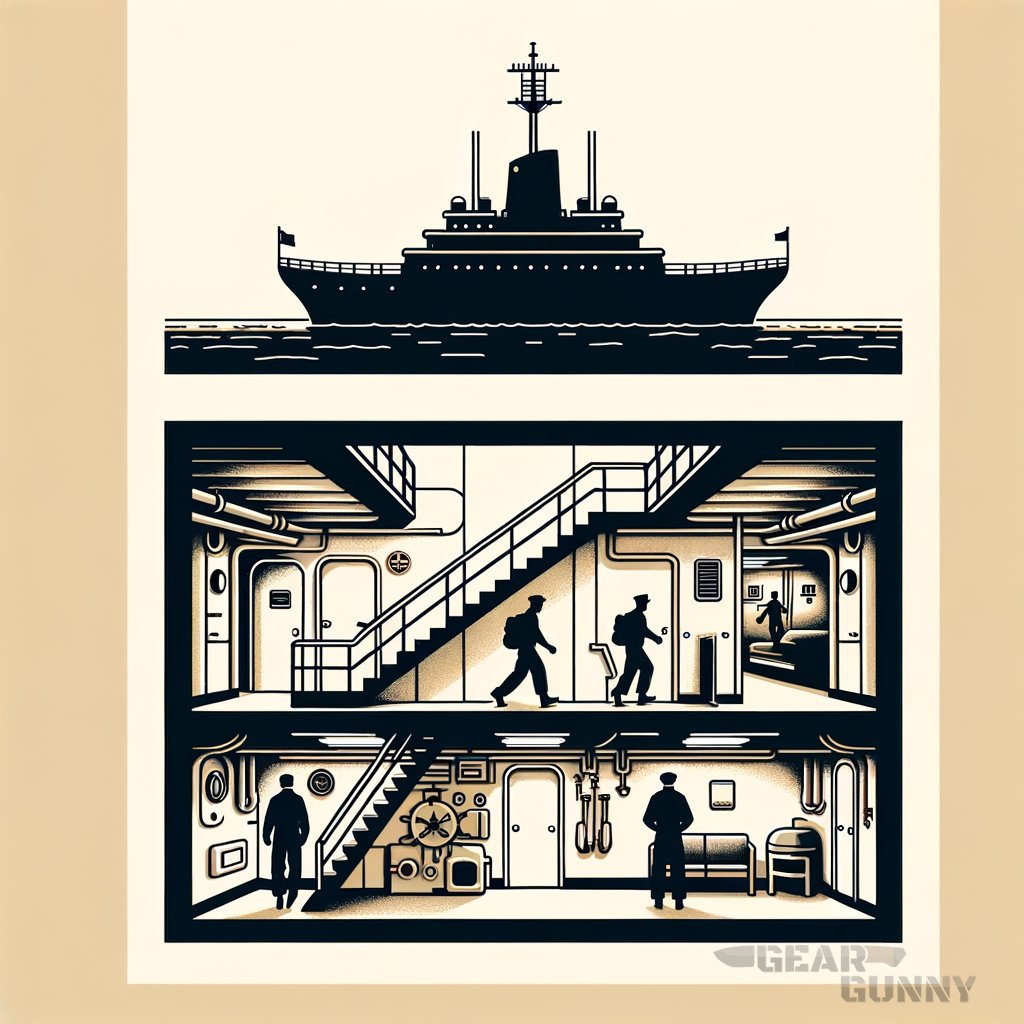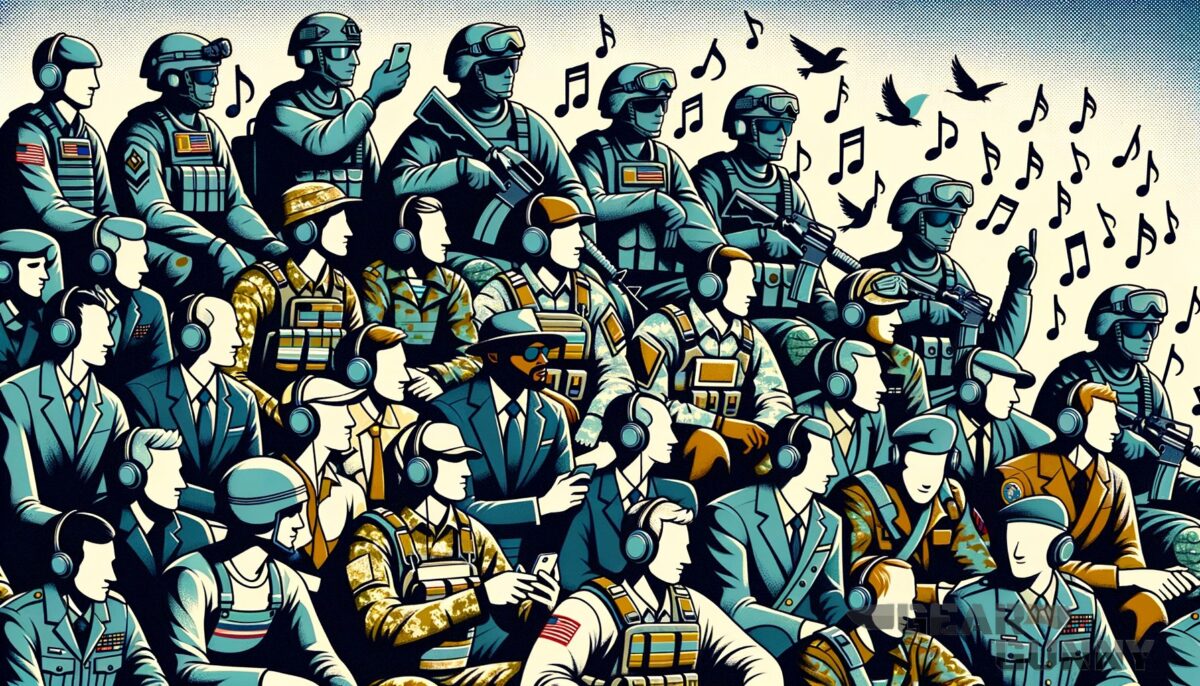Ever wondered what “going below” means when watching your favorite naval films or browsing through some top-notch gear like the best plate carriers out there? It’s a term that’s thrown around a lot in maritime circles. What does ‘below’ actually signify on board a ship?
In this post, we’ll dive into the details and uncover a few other naval tidbits that might pique your interest.
Key takeaways
- ‘Below’ refers to areas under the main deck of a ship, including quarters and engine rooms.
- Understanding naval terms improves communication and safety aboard.
- Learning the lingo is part of immersing oneself in naval culture.
In naval lingo, ‘below’ is a term that positions you within the ship’s structure. It’s used when someone is moving or located somewhere beneath the main deck of the ship. Now, this could be within the crew quarters, the engine room, or any inner compartment below the topmost deck.

Here’s a breakdown of the term ‘below’ in different contexts: * When you’re instructed to go ‘below,’ you’re being told to head down into the lower levels of the ship. * ‘Below’ can also signify that an activity or piece of equipment is housed within the lower decks. * Onboard naval or civilian ships, “secure the hatches below” might be a common order ensuring that lower decks are tightly closed off.
Throughout the history of seafaring, this term has been quite pivotal in shipboard communication. It allows for a quick and efficient way to direct movement and activity sea dogs. From seasoned officers to green deckhands, understanding this term is a must for ship life.
In my opinion, as someone who’s more familiar with combat boots on the ground than with navigating the high seas – “below” in naval terms is a bit like “in the weeds” for us Marines. It means you’re right in the thick of it, where the action happens out of sight. Just like when you’re gearing up with the finest tactical boots, knowing your way around a ship’s layout is crucial for shipboard efficiency and safety.
There’s this one story I recall hearing from a navy vet buddy of mine. During a particularly rough storm, he was ordered to “get below” as the ship was battening down the hatches. He told me it was like a scene straight out of an old war movie, running down metal ladders and hearing the ocean raging against the hull – intense and unforgettable.
It adds a whole layer of appreciation for the precision and urgency that naval language carries.
5.11 Rush 24 Tactical Backpack

5.11 Rush 24 Tactical Backpack
What does ‘Below’ specifically refer to on a ship?
On a ship, ‘below’ is the term used to describe areas under the main deck. This could include crew quarters, mess halls, storage areas, and engineering spaces.

- Navigating ‘below’ requires familiarity with the ship’s layout and is crucial during emergency situations.
- Signage and standard procedures help ensure everyone on board understands directions that involve going ‘below’.
Accessing the right gear for different shipboard tasks is also key. For instance, having the best tactical gloves can make working below deck, where you might deal with machinery or potentially hazardous materials, safer and more efficient.
“Navigating the sea of maritime speak can be smooth sailing with these pointers. Mastering maritime-speak isn’t just about hitting the books; it’s about diving into the culture and practices that make the navy unique.”
Importance of ‘Below’ for crew members
The term signifies more than just a location; it represents a shift from the open sea to the heart of ship operations.
- ‘Below deck’ work is usually less visible but vital for the safe operation of the ship.
- Crew members assigned ‘below’ carry out tasks critical to everyone’s welfare onboard.
When it comes to personal gear for such duties, crew members would fare well with items designed for tough conditions, like durable tactical belts, ensuring that they are well-equipped to handle the variety of challenges ‘below’.
How is ‘Below’ used in day-to-day operations?
Day-to-day operations of a ship involve numerous commands and terms, with ‘below’ being among the most common.
- Crew members might be instructed to store gear below or to retire to their quarters ‘below decks’ at the end of their shift.
- Maintenance or emergency procedures usually require personnel to move ‘below’ swiftly and with purpose.
For those looking to replicate the tight shipboard operations, field airsoft enthusiasts can learn from these practices to enhance their own tactical techniques and gear selection.
Similar terms in a naval context
In addition to ‘below,’ other naval terms also refer to specific locations on a vessel:
- ‘Aft’ and ‘fore,’ which denote the back and front of the ship, respectively.
- ‘Starboard’ and ‘port’ indicate the right and left sides when facing the bow.
Grasping these terms is a part of learning the maritime language, which is as complex and nuanced as the operation of the ships themselves.
Being proficient in shipboard language
Solid knowledge of naval terms is vital for clear communication and operation efficiency.
- Language proficiency impacts everything from day-to-day management to crisis response.
- Crew members and naval enthusiasts alike usually pride themselves on their nautical vocabulary and its importance in maintaining tradition and safety at sea.
Interested in acquiring military-grade language skills? Dive into the meaning behind Marine Corps terms and phrases to broaden your tactical communication toolkit.
Distinctions between ‘Below’ and ‘Bottom’
While ‘below’ refers to locations beneath the main deck, ‘bottom’ typically refers to the actual base or lowest part of the ship, its hull resting in the water.
- These distinctions may seem minor but are crucial in the precision-oriented world of naval operations.
- Understanding the subtle differences helps avoid confusion during high-stakes tasks aboard.
Impact on non-naval applications
Naval terminology, including ‘below,’ usually carries over into other industries, such as commercial shipping and leisure boating.
- The structure and discipline of naval language provide a useful framework for all seafaring entities.
- Even in recreational settings, using correct terms like ‘below’ can enhance the maritime experience.
Before the table, it should be noted that understanding the structure and terms like ‘below’ is only part of the naval lexicon. Another aspect is the equipment and readiness associated with these terms. Whether you are prepping for a mission or just need the most efficient gear, having the best plate carriers can make a significant difference, much like knowing your way ‘below’ can aboard a ship.
Comparative table of naval terms
| Naval Term | Description | Equivalent/Application |
|---|---|---|
| Below | Areas beneath the main deck | Crew quarters, engine room |
| Aft | Rear section of the ship | Steering equipment, aft deck |
| Fore | Front section of the ship | Bow, forecastle |
| Starboard | Right-hand side when facing the bow | Right railing, starboard hull |
| Port | Left-hand side when facing the bow | Left railing, port hull |
| Bottom | Base or lowest part of the ship’s hull | Ship’s hull in contact with the water |
If you’re keen on sharpening your naval terminology skills or just want to know your way around the lingo, there are a few extra steps you can take. Navigating the sea of maritime speak can be smooth sailing with these pointers.
- Read naval literature: Pick up some classic maritime novels or modern navy SEAL biographies to see the terminology in action.
- Visit naval museums: Get hands-on experience and usually hear veterans share firsthand knowledge.
- Play naval strategy games: Many games use accurate terms, and it’s a fun way to learn.
- Join forums or groups: Discussions with naval enthusiasts or veterans can be incredibly informative.
- Watch documentaries: A visual and auditory learning experience can help reinforce your understanding of terms like ‘below’.
Before you deck-swab and scuttlebutt, let’s lay out the do’s and don’ts in a handy table to steer clear of any shipwrecked communication.
Dos and don’ts of learning naval terminology
| Dos | Don’ts |
|---|---|
| Do immerse yourself in naval culture and history. | Don’t rely solely on movies for accurate terminology. |
| Do interact with current or former naval personnel. | Don’t ignore the context in which terms are used. |
| Do practice using the terms in conversation. | Don’t use jargon you’re not confident with. |
| Do use educational resources and tools. | Don’t overlook the importance of non-verbal shipboard communication cues. |
| Do study deck plans and ship layouts. | Don’t confuse similar-sounding naval terms. |

Whether you’re a sea-faring veteran, a maritime enthusiast, or someone with a passing interest in naval operations, understanding shipboard language can be both beneficial and cumbersome. Let’s navigate through the pros and cons.
Advantages
- Enhanced communication: Clear and concise understanding among crew members and in naval-themed activities.
- Increased safety: Precise terminology can prevent misunderstandings that could lead to accidents.
- Cultural immersion: Learning the terms is essential for anyone who wants to be part of the naval community.
- Professional development: Essential for careers in the maritime industry or naval history studies.
Disadvantages
- Complexity: Naval terminology can be vast and intricate, making it overwhelming for beginners.
- Context-specific: Some terms have different meanings in different situations, which can be confusing.
- Time-eating: Learning the language of the sea requires a considerable investment of time and effort.
- Limited use: Outside of maritime circles, you may find few opportunities to use this specialized vocabulary.
If you are a visual learner, check out this video titled ‘Intro to Naval Vocabulary’
Frequently asked questions (FAQ)
How do the terms ‘below’ and ‘bilge’ differ in naval usage?
The term ‘below’ generally refers to any space underneath the main deck of the ship, whereas ‘bilge’ is a specific area at the very lowest part of the ship where the two sides meet at the bottom. The bilge usually collects water and must be regularly pumped out to prevent water from accumulating.
Is the command ‘All hands below’ still used on modern ships?
Yes, the command ‘All hands below’ can still be heard on modern ships, particularly in naval contexts. It’s a call for all crew members to descend to the lower decks, either for briefing, safety drills, or sheltering during adverse conditions.
What’s the primary benefit of knowing terms like ‘below’ for recreational boaters?
For recreational boaters, knowing terms like ‘below’ is beneficial for safety and clear communication, especially during stressful situations or when engaging with other maritime professionals. It helps maintain a high standard of seamanship and can aid in emergency response effectiveness.
Final thoughts
As we secure the hatches on our discussion about the term ‘below’ and its significance in naval terminology, remember that these phrases are more than mere words; they are part of a deep, traditional lexicon that’s been shaped by centuries of maritime culture. Whether you’re a naval enthusiast or someone who appreciates military precision, the language of the sea has something to offer.
What’s your favorite naval term, and do you find maritime lingo as fascinating as tactical gear? I read and reply to every comment. If you found this article helpful, share it with a friend, and check out my full blog for more tips and tricks on tactical military equipment and techniques.
Thanks for reading and always stay on target with your maritime knowledge.















